
Argunite Golem
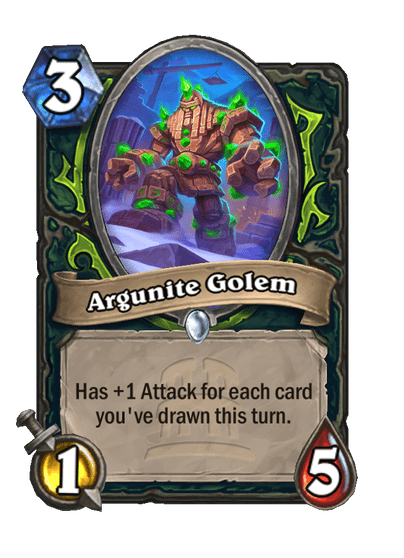
Golem is a baseline 2/5 on your turn, because you’re guaranteed to draw at least one card. On the opponent’s turn, it’s just a 1/5. This seems like a very weak play on curve since it’s a bit too easy for your opponent to value trade into the Golem and take advantage of its low attack value. For this to be a big damage source, you also need to draw a significant number of cards. For all that hard work, Vicious Slitherspear looks like a superior card that should deal more damage per mana spent, while having its attack persist on the opponent’s turn so it’s not a sitting duck.
We find it a bit strange that this card is so much worse at its baseline, and so much harder to activate, compared to a neutral 1-drop that’s not even close to being overpowered.
Score: 1
Disciple of Argus

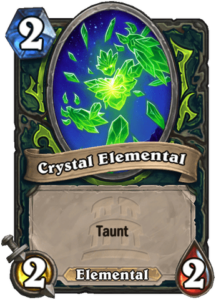
We’re not sure what this card is doing in this set. There’s no deathrattle synergy for Demon Hunter in TITANS beyond Argus being able to discover a deathrattle minion with his worst ability. Disciple of Argus’ initial body is terrible, while the deathrattle is barely worth the mana cost invested. Compare this to Sigil of Summoning, a card that’s barely seen any play, and we don’t think this 3-drop is worth having a conversation over.
Score: 1
Eredar Deceptor

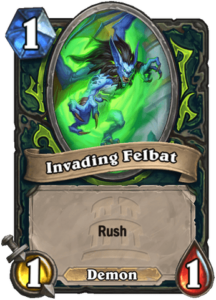
This is a 4 mana 3/5 when you play this card on curve. We’re not sure how much later in the game we are supposed to play this 4-drop, to combine it with card draw effects, just so we can summon a few 1/1 rushers. The only remotely playable application for this is in combination with Glaivetar, but we’re very reluctant to play this card in Outcast DH. It’s expensive for the deck and very useless outside of the 2nd charge of Glaivetar.
Score: 1
Crystalline Statue

This card reminds us of Kelpkeeper, but not in a good way. Despite costing twice the mana, Statue isn’t necessarily faster to activate. If you play it on turn 2, you need to draw a couple of cards to have it wake up on turn 3. That does seem reasonable on paper, albeit situational. The problem is that as you reach the later stages of the game, the card doesn’t become much easier to awaken. On the other hand, Kelpkeeper became trivial to awaken, turning into a 1 mana 4/4 rush. So, for a card to cost twice the mana and be harder to activate, all for one extra attack, Statue seems very questionable.
Of course, it’s a different class with different mechanics. Druid has ramp, while Demon Hunter specializes in card draw, but we still don’t know why we would play this.
Score: 1
Weight of the World

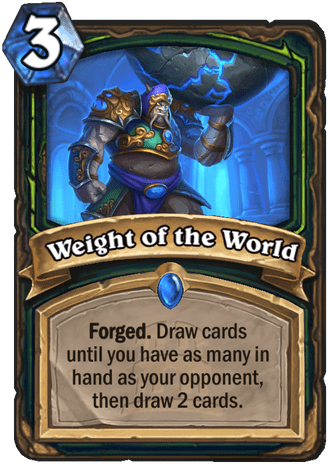
Arcane Intellect that turns into an upgraded Divine Favor after forging it. If you want to evaluate the forged form, you can think of it as paying 3 mana for Divine Favor and then 2 mana for the extra two cards you draw on top it. That theoretically makes it better in the faster matchups in case your opponent doesn’t have a lot of cards in hand, but then again, why would you even forge it against a faster deck?
Another funny kink about the forged version of this card is that if your opponent has a full hand, the second draw phase causes you to overdraw.
This all sounds like nitpicking, but these are small issues that compound a bigger problem. If we’re playing this card, it means we’re playing a relatively faster deck that dumps cards from hand to take advantage of the Divine Favor effect. In that case, spending mana forging this card becomes a problem. We’re paying 5 mana total for an upgraded Divine Favor, but we’re also not developing board or dumping other cards to make this Divine Favor effective. This card is in contradiction with itself, and we don’t understand why we would use it over the much better options available in the class. An Arcane Intellect isn’t quite good enough.
Score: 1
Momentum

Momentum costs 4 mana to deal 4 damage at its baseline. Remember that we’re always drawing at least one card at the start of our turn, making it discounted to 4 every time.
The damage to mana ratio here isn’t great, but Demon Hunter has a lot of cheap card draw it can use to discount it. The best part about Momentum that you don’t see with other cards in this set with similar conditions, is that you don’t need to pay any mana to initially set it up.
Momentum’s problem is its fit with the current tools available. This spell clashes with both Glaivetar and Magnifying Glaive since you’re required to use your attack charge to draw with these weapons. You need to rely on the other draw elements in these supportive shells to discount Momentum, which makes it more difficult to use.
Score: 2
Runic Adornment

Runic Adornment discovers a cheap spell you can play as a follow up on turn 3, but you also shuffle two copies of it into your deck. These copies are cast when drawn, hitting a random target if they’re targeted, while discovering a random card if they’re a discover spell.
This card costs 2 mana and develops no bodies on the board, which seems very slow for a discover card. Compare this to Kaja’mite Creation and it’s not looking great. The shuffling upside is also slow and has no guarantee to have any impact on the game.
There is one utilization that could be Runic Adornment’s saving grace. Since it’s a spell that discovers another spell, it’s a very good enabler for Felscale Evoker. Big Demon Hunter has a high priority on utilizing these kinds of cards, which is why Illidari Studies and Taste of Chaos are so important for that deck. Runic Adornment can add more consistency in activating Evoker in time. Beyond that, we don’t see a reason to play it in another deck. This is much worse than Teacher or Vizier in Relic DH since the spells you shuffle into your deck clash with Relic of Dimensions.
Score: 2
Mythical Terror

Some players might see this demon as a good fit in Big Demon Hunter, but we can’t agree, at least when it comes to primarily putting it in your deck. Big DH needs to cheat out threats with Felscale Evoker, threats that can kill the opponent. Terror is a survivability demon. Sure, it’s great if you cheat it out with Evoker against an aggressive deck, but what happens when you pull this out against a Control Priest? You’re suddenly not winning that game. Against the aggressive decks, you have your survivability combo with Arcanist/Unleash Fel, one that does not interfere with Evoker.
There is one workaround for Terror, which is running it inside an ETC. That gives you the option to lean into aggressive matchups without interfering with Evoker in the slow matchups. Terror could also be a stabilization tool in other decks such as Relic DH, because of the discount potential through Dimensions and how much Terror can farm some decks, though competition for slots is very high. The card resembles Hollow Hound, though obviously not nearly as good.
Score: 2
Jotun, the Eternal

Jotun is a very slow body with potentially a massive long-term payoff. Once you play him, the first spell you draw on each turn is copied and cast at random enemies. The original spell is still added to your hand, so you get a free effect cast.
Note that the spell doesn’t have to be drawn first. You could draw a minion at the start of your turn, cast a Spectral Sight, find an Unleash Fel with it, and Jotun’s effect will still trigger.
The immediate and obvious low hanging fruit for Jotun is to be included in Relic DH. The idea of being able to get free copies of relics sounds very tempting, helping you increase your threat density and scaling even further in the late game. However, Relic DH doesn’t run a lot of spells besides the Relics, and the other spells in the deck aren’t hugely beneficial as free copies. Casting an Illidari Studies and finding a random outcast card isn’t that amazing. What does sound quite strong is casting a copy of a Fizzle snapshot, provided you don’t have a full hand already.
Another deck that might play Jotun is Spell DH, for obvious reasons. But Spell DH churns through its deck very quickly, not giving much of a window for Jotun to get value. It could start running cards such as Deal with a Devil, which makes Jotun better.
Jotun has potential to be a very powerful late game card, and we do think it’s likely to find a competitive home, but it may not be as strong as it looks.
Score: 3
Argus, the Emerald Star

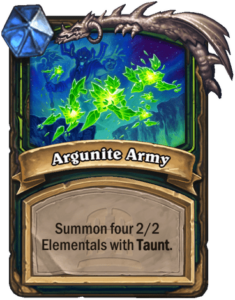
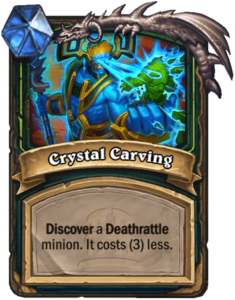
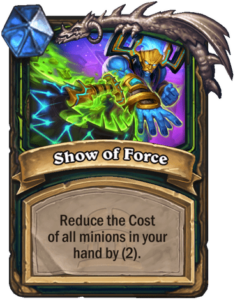

Argus has a very interesting static ability, which makes his positioning quite important. If you want to develop new minions to immediately impact the board, position them to the left of Argus and they’ll gain rush. If you’re casting a spell that summons minions, play it first and then drop your Argus to their right, since new summons from spells such as Relic of Phantasms will always spawn to the right of an existing board!
Alternatively, if you have minions in play, you can drop Argus to their left and have them attack with lifesteal, giving you a lot of recovery. Now that we understand his persistent effect, let’s look at his abilities.
Crystal Carving is going to be the last ability you cast if Argus manages to survive three turns. Discovering a deathrattle minion and having it cost 3 less doesn’t seem very impactful. It’s one of the worst TITAN abilities we’ve seen.
Show of Force discounts all minions in your hand by 2. Now we’re talking. The ability to discount all minions in your hand can lead to tremendous mana advantages for the rest of the game. This is a very powerful ability you can use to set up a very big swing later in the game. Seems very appropriate to cast this if you don’t feel threatened when dropping Argus.
Argunite Army summons 4 2/2 Elementals with taunt. Note that two of these will spawn to the left of Argus, while two will spawn to his right, gaining lifesteal. This is a huge play for the board, allowing you to both clear enemy threats and protect yourself at the same time. This ability makes it very difficult for the opponent to kill Argus through minion trades.
Argus seems strong thanks to his last two abilities. The card seems very powerful in Relic DH, where it can be devastating after a Dimensions discount, and helps turn your Relic of Phantasms into a big protective tool. The deck is also very heavy on minions, so the mass discount effect sounds extremely enticing. Big Demon Hunter can similarly benefit from Argus by turning its big demons into life stealing giants.
We’re pretty sure every Demon Hunter deck that looks to survive to turn 7 is going to want to include Argus. The only question is whether Outcast DH may not appreciate such an expensive card, but it might not even care. The discount ability on an Outcast DH hand could be crazy too. This card is just crazy.
Score: 4
Final Thoughts
TITANS Set Rank: 10th
Overall Power Ranking: 4th
Most of the Demon Hunter set seems to promote a strategy that does not exist and is in contradiction with itself. These cards could be unintuitive, hard to theorycraft and turn out well, but that would be one of the biggest shocks of the expansion.
Luckily for Demon Hunter, it might be the only class in the game that can afford to skip one expansion, since it’s already so versatile.
Relic DH is an archetype that normally thrives in late game battles. It will be interesting to see whether the increased competition is able to dent its late game dominance. Some of the potential emerging strategies certainly have the tools to give Relic DH some fits, but Demon Hunter does have its own upgrades to contest these challengers. Jotun is a greedy, but potent weapon that can scale relics even harder, while Argus can allow the Demon Hunter to outpace its opponents through its incredible mana reduction ability. Argus is also a big boost in Demon Hunter’s survivability.
Outcast DH might have gotten nothing from this set, but its supreme early game board control should line up well against emerging strategies. We’ll be surprised if it doesn’t manage to dominate Mechs, the premier aggressive tribe being promoted this expansion. It excels at pushing decks off the board and embarrassing strategies that rely on board presence to activate synergies. However, increased off-board power in the format could present an issue. The fact that Outcast DH seemingly doesn’t get anything new or exciting could hurt its visibility too.
Spell and Big DH have also mostly received minor upgrades. Spell DH may try to leverage Jotun, while Big DH will attempt to increase the consistency of Evoker and enhance its flexibility. Both archetypes, much like Outcast DH, could suffer from visibility issues.
Demon Hunter is going to suffer a blow to its play rate and possibly power. The force of the punch is the main question and providing a concrete answer here is taking a shot in complete darkness. Relic DH is an extremely popular archetype that needs to suffer from a disastrous launch to disappear. If it manages to hold off its late game challengers, it will continue to compete. But if a new strategy manages to take over the late game, Demon Hunter may find itself on surprisingly shaky grounds without its primary niche. It’s never a good thing to skip an expansion.

Just like Starfox says: Thank you zacho! You really make it possible for me to enjoy this game in its full potential!
>If your opponent has a big threat on the board, Golganneth takes care of it.
Not if it has divine shield 🤣
Thx for the good work!
I always enjoy reading your stuff!
Thanks for the review. I appreciate your work. Good luck with the launch!
Of course it’s good with Implock; it’s an IMPrisoned Horror.
I don’t often see many comments on here, so I’ll just say thank you for all of your hard work on this. Not only are you analyzing every card and it’s possibilities, but you’re doing detailed write ups on the potential of each card. Every pre-expansion I look forward to this preview and it never disappoints!
first